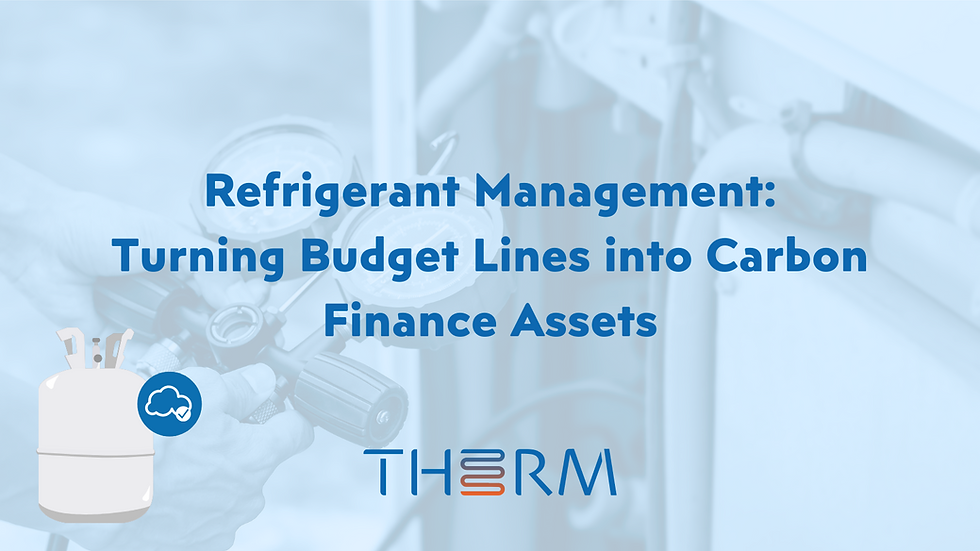Refrigerant Carbon Credits™: Permanent, Additional, Attainable, and Guaranteed.
- Fritz Troller
- Jul 1, 2022
- 3 min read
Updated: Aug 8, 2022
We understand that depicting a canister of R-404a in your annual report isn't exactly exciting for everyone. When most people think about protecting the environment, they don't picture cooling equipment. We're on a mission to change that.
Our projects create Refrigerant Carbon Credits™ that each represent one real, permanent, irreversible emission reduction. Each credit produced is an opportunity to invest in what Project Drawdown calls the top solution to the climate crisis: addressing our refrigerant problem.
Permanent environmental action
Unlike other carbon projects that are susceptible to reversal, Refrigerant Carbon Credits™ are wholly permanent.
Where a forest carbon project is at risk of fire, flood, drought, pestilence, or illegal harvesting, refrigerant carbon projects cannot be undone. Let's take illegal harvesting as an example.
You're a forest carbon project owner working diligently to manage your land in such a way that sequesters carbon. Despite your best efforts, your neighbor continually crosses into your land and harvests trees. Those now-harvested trees emit carbon dioxide as they decay. You already received carbon credits for them, but they are no longer sequestering carbon.
In contrast, imagine you are a grocery store owner. You upgrade your system to a transcritical CO2 system and receive carbon credits for the avoided emissions. If — and this is a big if — someone was able to break into your store, disassemble the new system and reinstall the old one, you would still never be able to reverse the emissions that you initially avoided.
That's the power of avoiding carbon dioxide instead of simply storing it; it can never be reversed.
Attainable environmental action
Refrigerant projects only require a shift in technology. A lot of these projects are initiated because the older systems require an upgrade, and Refrigerant Carbon Credits™ are used to incentivize a full upgrade to low-Global Warming Potential (GWP) projects. In the absence of RCCs, store owners may transition to refrigerants that still have a large environmental impact. With the revenue from RCCs, low-GWP refrigerant upgrades can be as economically feasible as traditional projects.
Other types of carbon projects aren't that simple and achievable. Forest carbon projects require a commitment of either 40 or 100 years. That's a minimum of a 40-year risk; either the credit buyer takes on the risk for a discount, or the owner takes on the risk for a premium price. The length of commitment is a large barrier to project adoption.
Refrigerant carbon projects fit seamlessly into a company's organizational goals. Switching to natural refrigerants helps operations and maintenance achieve their goals, as well as bolstering the company's sustainability efforts.
Additional environmental action
Additionality is one of the most important criteria for carbon projects. Additionality simply answers the question "would this action have occurred outside of the carbon markets?"
For forest carbon projects, the answer can get murky. Some projects are 40-year projects on land that is conveniently beginning a 40-year growth cycle. In the absence of the carbon credits, the land would have been managed exactly the same. Other projects occur on land owned by conservation entities with a mandate to protect their trees. Yet, they still qualify for carbon credits.
So how can you know if your investment truly makes a difference in the environment? Refrigerant carbon projects reward companies who go above and beyond what is legally required of them. The primary barrier to the adoption of low-GWP refrigerant systems is cost: natural systems can be more expensive than traditional systems. Refrigerant Carbon Credits are used to bridge that gap and create cost-effective environmental action.
Guaranteed environmental action
Another strength of refrigerant carbon projects is their ability to guarantee environmental results. When an organization switches from high-impact refrigerants, called HFCs, the gas is typically purified and reclaimed. This eliminates the production of virgin HFCs, and ensures that the environmental impact is realized. A certificate of reclamation is undeniable and irreversible by an EPA-certified entity. If an Ozone Depleting Substance gas (the precursor refrigerants to HFCs) is destroyed, a certificate of destruction is issued by EPA certified entity.
Comparatively, forest carbon projects face criticism about their results. If one landowner decides to stop harvesting, but the demand for timber remains high, then another landowner must harvest more in order to meet demand. Therefore, no real environmental impact is realized. Instead, the emissions simply shift to another landowner.
With the destruction or reclamation of refrigerants, there is no possibility of emissions shifting. Each Refrigerant Carbon Credit™ represents the most permanent, additional, attainable, and guaranteed way to eliminate a significant source of the climate crisis.
Kinda starts to paint that canister of R-404a in a different light, yeah?




